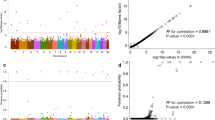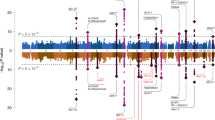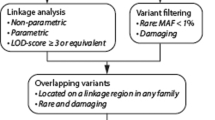Abstract
An intracranial aneurysm (IA), which results in a subarachnoid hemorrhage with a high mortality on rupture, is a major public health concern. To identify genetic susceptibility loci for IA, we carried out a multistage association study using genome-wide single nucleotide polymorphisms (SNPs) in Japanese case–control subjects. In this study, we assessed evidence for association in standard approaches, and additional tests with adjusting sex effects that act between genetic effect and disease. Consequently, five SNPs (P=1.31 × 10−5 for rs1930095 of intergenic region; P=1.32 × 10−5 for rs4628172 of TMEM195; P=2.78 × 10−5 for rs7781293 of TMEM195; P=4.93 × 10−5 for rs7550260 of ARHGEF11; and P=3.63 × 10−5 for rs9864101 of IQSEC1) with probabilities of being false positives <0.5 were associated with IA in Japanese population, and the susceptibility genes could have a role in actin remodeling in the ELN/LIMK pathway. This study indicates the presence of several susceptibility loci that deserve further investigation in the Japanese population.
Similar content being viewed by others
Log in or create a free account to read this content
Gain free access to this article, as well as selected content from this journal and more on nature.com
or
References
Inagawa, T., Tokuda, Y., Ohbayashi, N., Takaya, M. & Moritake, K. Study of aneurysmal subarachnoid hemorrhage in Izumo City, Japan. Stroke 26, 761–766 (1995).
Longstreth, W. T. Jr., Nelson, L. M., Koepsell, T. D. & van Belle, G. Clinical course of spontaneous subarachnoid hemorrhage: a population-based study in King County, Washington. Neurology 43, 712–718 (1993).
Schievink, W. I., Wijdicks, E. F., Parisi, J. E., Piepgras, D. G. & Whisnant, J. P. Sudden death from aneurysmal subarachnoid hemorrhage. Neurology 45, 871–874 (1995).
Onda, H., Kasuya, H., Yoneyama, T., Takakura, K., Hori, T., Takeda, J. et al. Genomewide-linkage and haplotype-association studies map intracranial aneurysm to chromosome 7q11. Am. J. Hum. Genet. 69, 804–819 (2001).
Akagawa, H., Tajima, A., Sakamoto, Y., Krischek, B., Yoneyama, T., Kasuya, H. et al. A haplotype spanning two genes, ELN and LIMK1, decreases their transcripts and confers susceptibility to intracranial aneurysms. Hum. Mol. Genet. 15, 1722–1734 (2006).
Akagawa, H., Narita, A., Yamada, H., Tajima, A., Krischek, B., Kasuya, H. et al. Systematic screening of lysyl oxidase-like (LOXL) family genes demonstrates that LOXL2 is a susceptibility gene to intracranial aneurysms. Hum. Genet. 121, 377–387 (2007).
Mineharu, Y., Inoue, K., Inoue, S., Kikuchi, K., Ohishi, H., Nozaki, K. et al. Association analyses confirming a susceptibility locus for intracranial aneurysm at chromosome 14q23. J. Hum. Genet. 53, 325–332 (2008).
Ruigrok, Y. M., Rinkel, G. J., van’t Slot, R., Wolfs, M., Tang, S. & Wijmenga, C. Evidence in favor of the contribution of genes involved in the maintenance of the extracellular matrix of the arterial wall to the development of intracranial aneurysms. Hum. Mol. Genet. 15, 3361–3368 (2006).
Ruigrok, Y. M., Rinkel, G. J. & Wijmenga, C. The versican gene and the risk of intracranial aneurysms. Stroke 37, 2372–2374 (2006).
Weinsheimer, S., Goddard, K. A., Parrado, A. R., Lu, Q., Sinha, M., Lebedeva, E. R. et al. Association of kallikrein gene polymorphisms with intracranial aneurysms. Stroke 38, 2670–2676 (2007).
Bilguvar, K., Yasuno, K., Niemela, M., Ruigrok, Y. M., von Und Zu Fraunberg, M., van Duijn, C. M. et al. Susceptibility loci for intracranial aneurysm in European and Japanese populations. Nat. Genet. 40, 1472–1477 (2008).
WTCCC. Genome-wide association study of 14,000 cases of seven common diseases and 3,000 shared controls. Nature 447, 661–678 (2007).
Broderick, J. P., Viscoli, C. M., Brott, T., Kernan, W. N., Brass, L. M., Feldmann, E. et al. Major risk factors for aneurysmal subarachnoid hemorrhage in the young are modifiable. Stroke 34, 1375–1381 (2003).
Krischek, B. & Inoue, I. The genetics of intracranial aneurysms. J. Hum. Genet. 51, 587–594 (2006).
Sankai, T., Iso, H., Shimamoto, T., Kitamura, A., Naito, Y., Sato, S. et al. Prospective study on alcohol intake and risk of subarachnoid hemorrhage among Japanese men and women. Alcohol. Clin. Exp. Res. 24, 386–389 (2000).
Yamada, S., Koizumi, A., Iso, H., Wada, Y., Watanabe, Y., Date, C. et al. Risk factors for fatal subarachnoid hemorrhage: the Japan Collaborative Cohort Study. Stroke 34, 2781–2787 (2003).
Skol, A. D., Scott, L. J., Abecasis, G. R. & Boehnke, M. Joint analysis is more efficient than replication-based analysis for two-stage genome-wide association studies. Nat. Genet. 38, 209–213 (2006).
Purcell, S., Neale, B., Todd-Brown, K., Thomas, L., Ferreira, M. A., Bender, D. et al. PLINK: a tool set for whole-genome association and population-based linkage analyses. Am. J. Hum. Genet. 81, 559–575 (2007).
Thomas, D. C. Statistical Methods in Genetic Epidemiology (Oxford University, New York, 2004).
Wacholder, S., Chanock, S., Garcia-Closas, M., El Ghormli, L. & Rothman, N. Assessing the probability that a positive report is false: an approach for molecular epidemiology studies. J. Natl Cancer Inst. 96, 434–442 (2004).
Chanock, S. Candidate genes and single nucleotide polymorphisms (SNPs) in the study of human disease. Dis. Markers 17, 89–98 (2001).
Samani, N. J., Erdmann, J., Hall, A. S., Hengstenberg, C., Mangino, M., Mayer, B. et al. Genomewide association analysis of coronary artery disease. N. Engl. J. Med. 357, 443–453 (2007).
Jackson, M., Song, W., Liu, M. Y., Jin, L., Dykes-Hoberg, M., Lin, C. I. et al. Modulation of the neuronal glutamate transporter EAAT4 by two interacting proteins. Nature 410, 89–93 (2001).
Hiroi, T., Someya, A., Thompson, W., Moss, J. & Vaughan, M. GEP100/BRAG2: activator of ADP-ribosylation factor 6 for regulation of cell adhesion and actin cytoskeleton via E-cadherin and alpha-catenin. Proc. Natl Acad. Sci. USA 103, 10672–10677 (2006).
Maekawa, M., Ishizaki, T., Boku, S., Watanabe, N., Fujita, A., Iwamatsu, A. et al. Signaling from Rho to the actin cytoskeleton through protein kinases ROCK and LIM-kinase. Science 285, 895–898 (1999).
Acknowledgements
We are grateful to the DNA donors and the supporting staffs for making this study possible. We thank Dr Hiroyuki Akagawa for his assistance with DNA specimen management. We also thank Makiko Funamizu, Midori Yamamoto, Kayako Fukuyama, Kozue Otaka, Eriko Tokubo, Hiromi Kamura and Miho Takabe for their technical help. This work was supported in part by CREST (Core Research for Evolutionary Science and Technology) of Japan Science and Technology (II) and a Grant-in-Aid for scientific research on Priority Area ‘Applied Genomics’ from the Japanese Ministry of Education, Science, Sports and Culture (II).
Author information
Authors and Affiliations
Corresponding author
Additional information
Supplementary Information accompanies the paper on Journal of Human Genetics website
Rights and permissions
About this article
Cite this article
Akiyama, K., Narita, A., Nakaoka, H. et al. Genome-wide association study to identify genetic variants present in Japanese patients harboring intracranial aneurysms. J Hum Genet 55, 656–661 (2010). https://doi.org/10.1038/jhg.2010.82
Received:
Revised:
Accepted:
Published:
Issue date:
DOI: https://doi.org/10.1038/jhg.2010.82
Keywords
This article is cited by
-
Co-existing of craniofacial fibrous dysplasia and cerebrovascular diseases: a series of 22 cases and review of the literature
Orphanet Journal of Rare Diseases (2021)
-
Intracranial Aneurysms: Pathology, Genetics, and Molecular Mechanisms
NeuroMolecular Medicine (2019)
-
Genome-wide association analysis identifies new candidate risk loci for familial intracranial aneurysm in the French-Canadian population
Scientific Reports (2018)
-
Genetic Risk Factors for Intracranial Aneurysm in the Kazakh Population
Journal of Molecular Neuroscience (2018)
-
CDKN2BAS gene polymorphisms and the risk of intracranial aneurysm in the Chinese population
BMC Neurology (2017)



